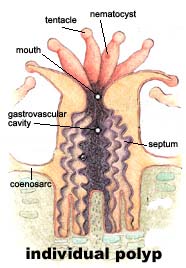Corals are not plants but animals 😕 !!
Corals are the simplest animals. They do not have organs,such as heart. They belong to phylum Cnidaria,a group of invertebrates which also includes the Jellyfish. Corals are made up of tiny organisms called Polyps. The polyps are soft-bodied but secrete limestone skeletons for support. Large, iconic reefs are formed when many, many polyps come together and build on one another.
Coral reefs get their colorful hues from algae called zooxanthellae. The coral polyps themselves are actually see-through! Polyps and zooxanthellae have a symbiotic relationship, where coral polyps get their food and color from the algae in exchange for providing housing and protection to the algae.
Hard corals are the primary reef-building corals. Hard corals that form reefs are called hermatypic corals. Soft coral, also known as Alcyonacea and ahermatypic coral, do not produce a rigid calcium carbonate skeleton and do not form reefs.
Precipitation of calcium from the water is necessary to form a coral polyp's skeleton. This precipitation occurs when water temperature and salinity are high and carbon dioxide concentrations are low. These conditions are typical of shallow, warm tropical waters. Warm water flows along the eastern shores of major land masses.
Most corals grow on a hard substrate. Coral reefs can also be started on the shells of sunken boats. In fact, to help preserve different sea biomes, the navy will sink old ships to allow a coral reef to grow.Wherever coral reefs grow, the sea bed is more stable.
Reefs help sea grass and other sea plants survive in the area. The more plants are growing on the sea bed, the less impact storms and surges will have on seabed too. All of the plants that are protected by the coral reef prevent the bottom of the bed from being washed out deeper.
Reefs are where many fish and sea creatures choose to spawn. The protected environment of the reef means their eggs will be safe from predators.Sea stars, sea cucumbers, and sea urchins live on the reef.Shrimps, crabs, lobsters, and other crustaceans find protection from predators in crevices or between coral branches.
Most of the reefs, with a few exceptions are found in tropical and semitropical waters, between 30° north and 30° south latitudes.Shallow tropical reefs in the Indian and Pacific Oceans boast the most coral species.
The Coral Triangle is a marine area located in the western Pacific Ocean. It includes the waters of Indonesia, Malaysia, the Philippines, Papua New Guinea, Timor Leste and Solomon Islands, named for its staggering number of corals.Over 120 million people live in the Coral Triangle and rely on its coral reefs for food, income and protection from storms.
Reef development is generally more abundant in areas that are subject to strong wave action. Waves carry food, nutrients, and oxygen to the reef; distribute coral larvae; and prevent sediment from settling on the coral reef.
When the water is clouded with sediment, the algae, and therefore the coral, cannot grow as quickly because it doesn’t receive as much sunlight. Sediment and plankton can cloud water, which decreases the amount of sunlight that reaches the zooxanthellae.
Corals need saltwater to survive and require a certain balance in the ratio of salt to water. This is why corals don’t live in areas where rivers drain fresh water into the ocean (“estuaries”).
Corals require waters with low nutrient content, and the addition of nutrients favors species that disrupt the balance of the reef communities. Nutrient-rich water causes phytoplankton to thrive in coastal areas, often causing algal blooms. It also encourages the growth of algae, which compete with corals for space on the reef.
The coral’s hard calcium carbonate skeletons contain bands, like tree rings, that record environmental changes in temperature, water chemistry and water clarity.
Fishing practices such as cyanide fishing (spraying cyanide in the water stuns the fish to make them easier to catch), "blast fishing" with explosives and over-fishing with trawlers can destroy a thousand-year-old coral reef in a matter of minutes.Over-fishing of herbivorous fish can lead to high levels of algal growth.
Many discarded plastic is broken down into what is known as micro plastics, tiny pieces that are mistaken by coral polyps as food and ingested. In 2020, the Pacific nation of Palau has become the first country to ban sun cream that is harmful to corals and sea life.
Ocean acidification (addition of more and more carbon dioxide to oceanic waters) threatens coral reef futures by reducing the concentration of carbonate ions that corals need to construct their skeletons. Ocean acidification could also compromise the successful fertilization, larval settlement and survivorship of corals.
Coral Bleaching ➤When coral get stressed out by things like pollution or high temperatures (often caused by climate change), the coral kicks the zooxanthellae out. No algae=no color=coral bleaching. This bleaching event is a warning sign for the corals death.However sometimes, corals,again under normal oceanic conditions(right salinity ,right temperatures etc.) can come out of this event to regrow again.



Comments
Post a Comment